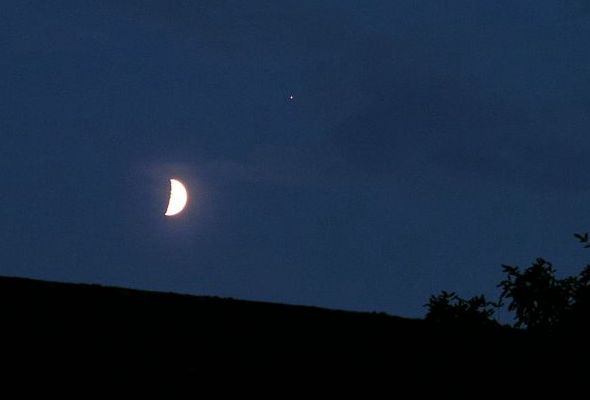 |
On 13th July 2005 there was a conjuction of Jupiter and the Moon, not a rare event
but pretty to record. My view was obstructed by clouds until only a few hours before moonset.
Click on the image to see some more pictures. |
|
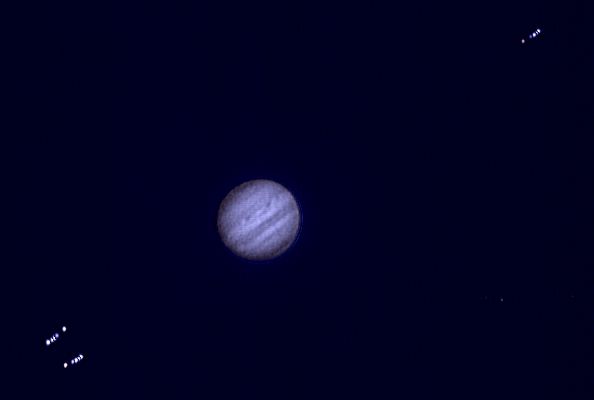 |
Jupiter's satellites on the move. This is a superimposition of five images taken
over a period of an hour. Click on the image to see more pictures taken
on 7th June 2005. |
|
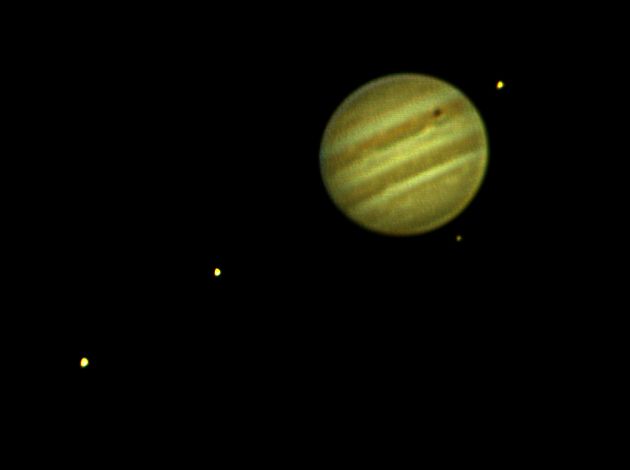 |
This is an image of Jupiter and his four Galilean satellites taken on 28th May 2005.
The satellites were all very close to the planet as seen from Earth.
Click on the image to see more pictures taken that night. |
|
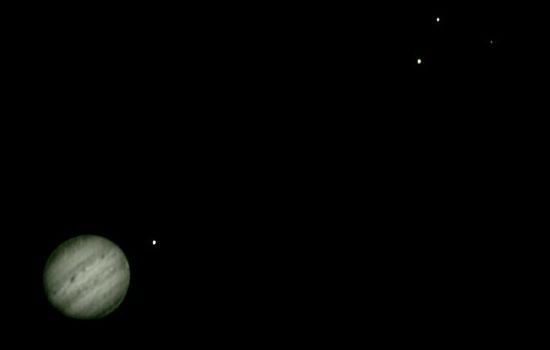 |
This is an image of Jupiter and his four Galilean satellites taken on 27th May 2005.
Click on the image to see three pictures taken that night with different light and exposures. |
|
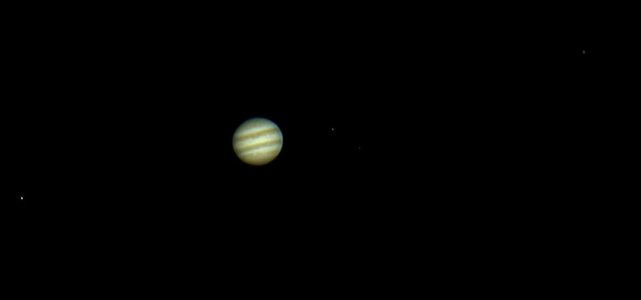
|
This is an image of Jupiter and his four Galilean satellites taken on 11th May 2005.
Move your mouse over the image to see an enhanced version that shows the satellites better.
Click on the image to see a larger version which is a mosaic of two images. |
|
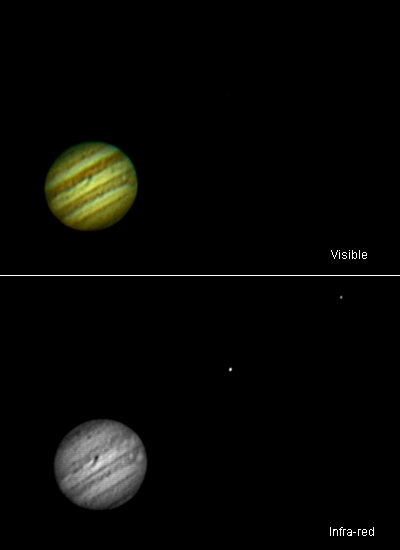
|
These two pictures were taken within 7 minutes of one another. Although the exposure had to be
longer for the IR image than the visible one, the gamma was the same for both and the reading on the
brightness meter in K3CCDTools was also the same. Not only is the detail on Jupiter clearer
(the GRS is more clearly visible) in the IR image, but the satellites show up nicely whereas they cannot be seen in the
image made with visible light. Europa, at least, is an icy satellite and probably reflects
light of all wavelengths fairly evenly, so one can only conclude that Jupiter absorbs more of the
infra-red light than it does of the visible.
Date and Time: 21st April 2005, 20:40 (IR) and 20:47 UT
Telescope: LX200 10-inch classic.
Camera: Toucam 740.
Capture: K3CCDTools, IR image 304 frames, 1/25", gain 49%, 0% gamma and B/W mode.
Visible image 305 frames. 1/100", gain 22%, 0% gamma and 100% saturation.
Processing: Registax3, IR image 148 frames, wavelets 1-4 = 10, gamma 1.2
Visible image 200 frames, wavelets 1-4=10, histogram 8-180
|
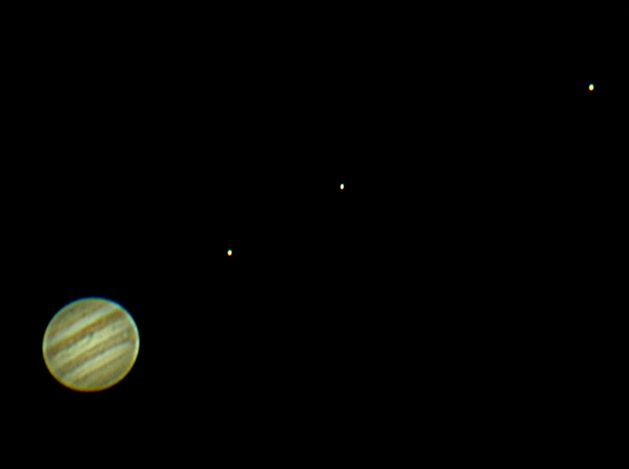
|
Now here is a picture, taken shortly after the pictures above, which shows three of the Galilean satellites
in visible light. Unfortunately Calisto was so far from Jupiter (more than twice the distance
of Ganymede) that even with my focal reducer I couldn't get it and the planet in the same frame.
Date and Time: 21st April 2005, 20:50 UT
Telescope: LX200 10-inch classic.
Camera: Toucam 740.
Capture: K3CCDTools, 312 frames, 1/100", gain 26%, 100% gamma and 100% saturation.
Processing: Registax3, 125 frames, wavelets 1-5 = 10, gamma 0.7.
|
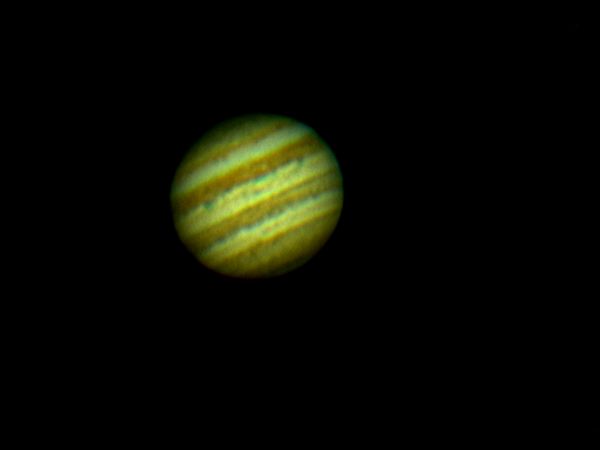
|
And finally a closer picture of Jupiter himself taken about an hour later by which time the GRS had
moved off the visible half of the disc.
Date and Time: 21st April 2005, 21:42 UT
Telescope: LX200 10-inch classic with X2 teleadaptor lens.
Camera: Toucam 740.
Capture: K3CCDTools, 327 frames, 1/33", gain 17%, 0% gamma and 100% saturation.
Processing: Registax3, 233 frames, wavelets 1-5 = 10, histogram 5-180, contrast 120, brighness -20.
|
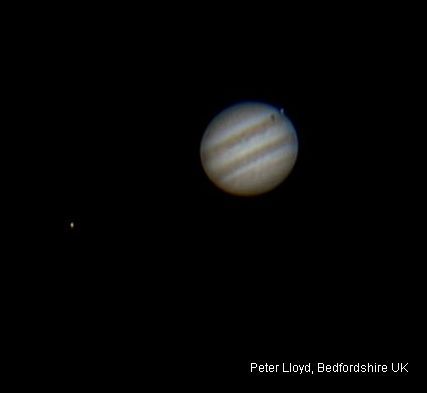
|
In this picture I have just caught Europa as it moves out from transiting the planet, and its
shadow is still visible on the clouds of Jupiter. Europa is closer to us than is the planet;
Jupiter had just passed opposition, so the Sun was "over my right shoulder" as it were, so Europa's
shadow is to its left as seen from Earth. Io is also visible; the other bright satellites were
too far from the planet to catch on this picture.
Date and Time: 10th April 2005, 21:25 UT
Telescope: LX200 10-inch classic.
Camera: Toucam 740.
Capture: K3CCDTools, 541 frames, 1/100", gain 20%, 87% gamma and 100% saturation.
Processing: Registax3, 280 frames, wavelets 1-3 = 10, histogram 10-200.
|
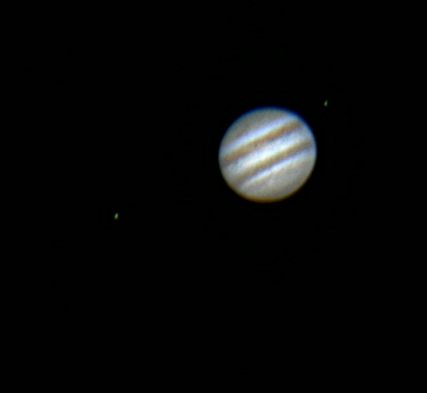
|
This picture was taken only 51 minutes after the one above and you can see how much the satellites have moved.
Date and Time: 10th April 2005, 22:16 UT
Telescope: LX200 10-inch classic.
Camera: Toucam 740.
Capture: K3CCDTools, 301 frames, 1/100", gain 38%, 50% gamma and 100% saturation.
Processing: Registax3, 169 frames, wavelets 1-5 = 10, Gamma 0.8.
|
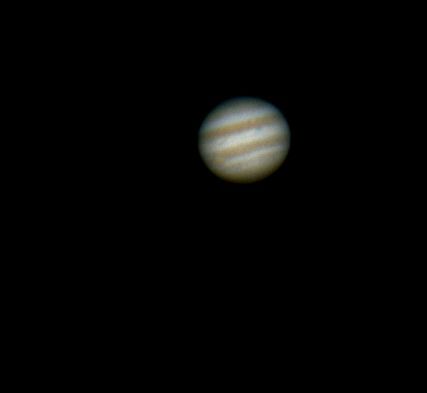
|
This picture was taken 1 hour 40 minutes after the one above when the Great Red Spot
(GRS) had moved into view. Unfortunately I exposed this picture for the details on the planet,
and the satellites have not come out. Also clouds were beginning to form, hence the increased exposure.
Date and Time: 10th April 2005, 23:56 UT
Telescope: LX200 10-inch classic.
Camera: Toucam 740.
Capture: K3CCDTools, 301 frames, 1/50", gain 38%, 0% gamma and 100% saturation.
Processing: Registax3, 175 frames, wavelets 1-3 = 10, histogram 10-150.
|
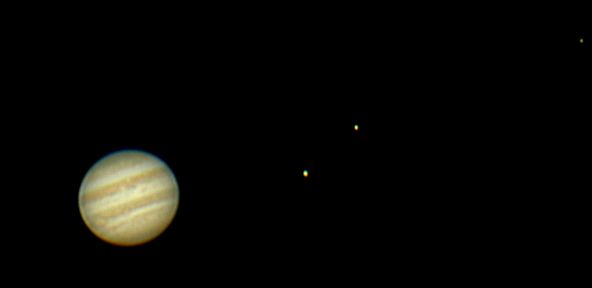
|
This picture of Jupiter with three of the Galilean satellites (move your mouse over the image to see
their names) was taken at 00:44 on 25th March 2005. In order to image the satellites as well as the planet
the gamma had to be set high and the exposure as long as possible without saturating the camera.
Date and Time: 25th March 2005, 00:44 UT
Telescope: LX200 10-inch classic.
Camera: Toucam 740.
Capture: K3CCDTools, 378 frames, 1/33", gain 19%, 100% gamma and saturation.
Processing: Registax3, 178 frames, wavelets 1-3 = 10, gamma 0.7, histogram 10-220.
|
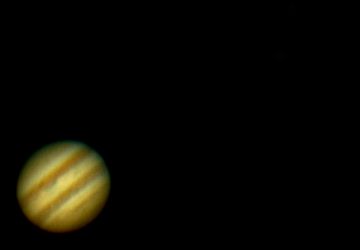 |
These four pictures were taken earlier the same night (24th-25th March 2005) with different filters.
This first one was taken (at 21:58 UT) in natural light, that is only with an IR-blocking filter. Note
the dark blue feature on the southern edge of the north equatorial belt (the upper of the two
dark bands).
This second one was taken (at 21:42 UT) in infra-red light; that is the IR-blocking filter was replaced by
an IR-pass filter. The exposure was adjusted to give the same reading on the brightness meter
in K3CCDTools as in the picture above. Note how the two satellites show up here when they didn't
in the visible-light. Also the dark blue feature in the image above shows up well
in the infra-red.
This may be because the satellites have greater reflectivity in the infra-red, but equally may be
caused by a change in the response of the camera when the gain is increased as was necessary
for these pictures in the infra-red.
(On some monitors these satellites do not show up well. Click on the IR image
to see all four pictures with the gamma increased to 1.5.)
This third picture was taken (at 21:50 UT) with a filter combination that isolated the red part of the spectrum
Again the satellites do not show up.
Finally this picture was taken (at 00:48 UT) specifically to image the planet. It was taken some 3 hours
after the first in this series, and by then the GRS had come into view.
|
|
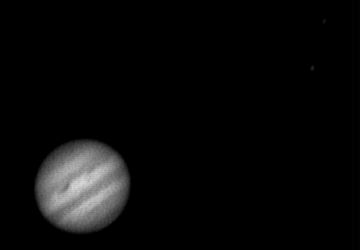 |
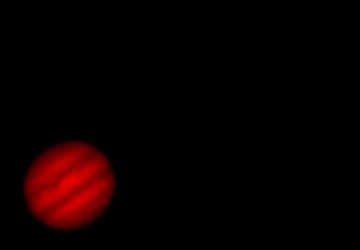 |
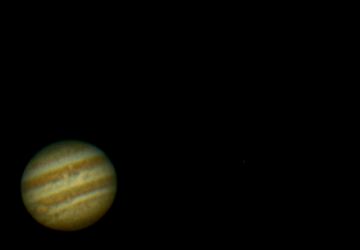 |

